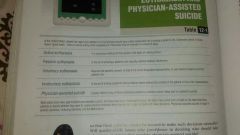![]()
![]()
![]()
Use LEFT and RIGHT arrow keys to navigate between flashcards;
Use UP and DOWN arrow keys to flip the card;
H to show hint;
A reads text to speech;
95 Cards in this Set
- Front
- Back
- 3rd side (hint)
|
Amniocentesis
|
A test whereby the physician withdraws a sample of amniotic fluid (the fluid surrounding the developing fetus inside the mother’s womb) from the uterus of a pregnant woman. The fluid is then tested for genetic or other conditions that may lead to abnormal development of the fetus.
|
|
|
|
Artificial Insemination
|
The mechanical injection of viable semen in the vagina.
|
|
|
|
Chromosome
|
A microscopic structure found within the nucleus of all living cells that carries genes responsible for the organism’s characteristics.
|
|
|
|
Clone
|
An organism produced asexually, usually from a single cell of the parent.
|
|
|
|
Cloning
|
The process by which organisms are created asexually, usually from a single cell of the parent organism.
|
|
|
|
DNA (deoxyribonucleic acid)
|
The combination of proteins, called nucleotides, that is arranged to make up an organism’s chromosomes.
|
|
|
|
Emancipated minor
|
Individuals in their mid- to late teens who legally live outside parents’ or guardians’ control.
|
|
|
|
Gene
|
A tiny segment of DNA found on a chromosome within a cell’s nucleus. Each gene holds the formula for making a specific enzyme or protein.
|
|
|
|
Gene therapy
|
Treating harmful genetic diseases or traits by eliminating or modifying the harmful gene.
|
|
|
|
Genetic counselor
|
An expert in human genetics who is qualified to counsel individuals who may have inherited genes for certain diseases or conditions.
|
|
|
|
Genetic discrimination
|
Differential treatment of individuals based on their actual or presumed genetic differences.
|
|
|
|
Genetic engineering
|
Manipulation of DNA within the cells of plants, animals, and other organisms through synthesis, alteration, or repair to ensure that certain harmful traits will be eliminated in offspring and that desirable traits will appear and be passed on.
|
|
|
|
Genetics
|
The science that accounts for natural differences and resemblances among organisms related by descent.
|
|
|
|
Genome
|
All the DNA in an organism, including its genes.
|
|
|
|
Heredity
|
The process by which organisms pass genetic traits on to their offspring.
|
|
|
|
Heterologous artificial insemination
|
The process in which donor sperm is mechanically injected into a woman’s vagina to fertilize her eggs.
|
|
|
|
Homologous artificial insemination
|
The process in which a husband’s sperm is mechanically injected into his wife’s vagina to fertilize her eggs.
|
|
|
|
Human Genome Project
|
A scientific project funded by the U.S. government, begun in 1990 and successfully completed in 2000, for the purpose of mapping all of a human’s genes.
|
|
|
|
Infertility
|
The failure to conceive for a period of 12 months or longer due to a deviation from or interruption of the normal structure or function of any reproductive part, organ, or system.
|
|
|
|
In vitro fertilization (IVF)
|
Fertilization that takes place outside a woman’s body, literally “in glass”, as in a test tube.
|
|
|
|
Mature minors
|
Individuals in their mid- to late teens who, for health care purposes, are considered mature enough to comprehend a physician’s recommendations and give informed consent.
|
|
|
|
Multipotent stem cells
|
Stem cells that can become a limited number of types of tissues and cells in the body.
|
|
|
|
Mutation
|
A permanent change in DNA.
|
|
|
|
Parens patriae
|
A legal document that gives the state the authority to act in a child’s best interest.
|
|
|
|
Pluripotent stem cells
|
Stem cells that can become almost all types of tissues and cells in the body.
|
|
|
|
Safe haven laws
|
State laws that allow mothers to abandon newborns to designated safe facilities without penalty.
|
|
|
|
Stem cells
|
Cells that have the potential to become any type of body cells.
|
|
|
|
Surrogate mother
|
A woman who becomes pregnant, usually by artificial insemination or surgical implantation of a fertilized egg, and bears a child for another woman.
|
|
|
|
Xenotransplantation
|
Transplantation of animal tissues and organs into humans.
|
|
|
|
Active euthanasia
|
A conscious medical act that results in the death of a dying person.
|
|
|
|
Brain death
|
Final cessation of bodily activity, used to determine when death actually occurs; circulatory and respiratory functions have irreversibly ceased, and the entire brain (including the brain stem) has irreversibly ceased to function.
|
|
|
|
Coma
|
A condition of deep stupor from which the patient cannot be roused by external stimuli.
|
|
|
|
Curative care
|
Treatment directed toward curing a patient’s disease.
|
|
|
|
Do-not-resuscitate (DNR) order –
|
Orders written at the request of patients or their authorized representatives that cardiopulmonary resuscitation not be used to sustain life in a medical crisis.
|
|
|
|
Durable power of attorney –
|
An advance directive that confers upon a designee the authority to make a variety of legal decisions on behalf of the grantor, usually including health care decisions.
|
|
|
|
Health care proxy –
|
A durable power of attorney issued for purposes of health care decisions only.
|
|
|
|
Hospice
|
A facility or program (often carried out in a patient’s home) in which teams of health care practitioners and volunteers provide a continuing environment that focuses on the physical, emotional, and psychological needs of the dying patient.
|
|
|
|
Involuntary euthanasia
|
The act of ending a terminally ill patient’s life by medical means without his or her permission.
|
|
|
|
Living will
|
An advance directive that specifies an individual’s end-of-life wishes.
|
|
|
|
National Organ Transplant Act –
|
Passed in 1984, a statute that provides grants to qualified organ procurement organizations and established an Organ Procurement and Transplantation Network.
|
|
|
|
Palliative care
|
Treatment of a terminally ill patient’s symptoms to make dying more comfortable; also called comfort care.
|
|
|
|
Passive euthanasia
|
The act of allowing a dying patient to die naturally, without medical interference.
|
|
|
|
Patient Self-Determination Act
|
A federal law passed in 1990 that requires hospitals and other health care providers to provide written information to patients regarding their rights under state law to make medical decisions and execute advance directives.
|
|
|
|
Persistent vegetative state (PVS)
|
Severe mental impairment characterized by irreversible cessation of the higher functions of the brain, most often caused by damage to the cerebral cortex.
|
|
|
|
Terminally ill
|
Referring to patients who are expected to die within six months.
|
|
|
|
Thanatology
|
The study of death and of the psychological methods of coping with it.
|
|
|
|
Uniform Anatomical Gift Act –
|
A recommendation of the National Conference of Commissioners on Uniform State Laws, that all states accepted, allowing individuals to donate their bodies or body parts, after death, for use in transplant surgery, tissue banks, or medical research or education.
|
|
|
|
Uniform Determination of Death Act
|
A proposal that established uniform guidelines for determining when death has occurred.
|
|
|
|
Uniform Rights of the Terminally Ill Act
|
A 1989 recommendation of the National Conference of Commissioners on Uniform State Laws that all states construct laws to address advance directives.
|
|
|
|
Voluntary euthanasia
|
The act of ending a dying patient’s life by medical means with his or her permission.
|
|
|
|
Access
|
The availability of health care and the means to purchase health care services.
|
|
|
|
Agency for Healthcare Research and Quality (AHRQ)
|
The lead federal agency responsible for tracking and improving the quality, safety, efficiency, and effectiveness of health care for Americans.
|
|
|
|
Baby boom generation
|
Those individuals born between 1946 and 1964.
|
|
|
|
Cost
|
The amount individuals, employers, state and federal governments, HMOs, and insurers spend on health care in the United States.
|
|
|
|
Epigenetics
|
The study of changes in gene activity that do not involve alterations to the genetic code, but are still passed down to at least one successive generation.
|
|
|
|
Genometrics
|
The science of determining how genes cause the expression of certain traits in individuals.
|
|
|
|
Gross domestic product (GDP)
|
The total value of goods produced and services provided in a country during one year.
|
|
|
|
Life expectancy
|
The number of years an individual can expect to live, calculated from his or her birth.
|
|
|
|
Life span
|
The number of years an individual actually lives.
|
|
|
|
Medical management
|
The management of patient care and populations.
|
|
|
|
Personalized medicine
|
The products and services that leverage the science of genomics and proteomics and capitalize on the trends toward wellness and consumerism to enable tailored approaches to prevention and care.
|
|
|
|
Pharmacogenomics
|
The science that defines how individuals are genetically programmed to respond to drugs.
|
|
|
|
Proteomics
|
The study of the proteins that genes create or “express.”
|
|
|
|
Quality
|
The degree of excellence of health care services offered.
|
|
|
|
Stakeholders
|
Those who have a vested interest in the health care industry in the United States, and in any efforts to reform the industry.
|
|
|
|
State Children’s Health Initiative Program (SCHIP)
|
A program enacted by the Balanced Budget Act of 1997 to help low-income children under 19 who are not covered by Medicaid.
|
|
|
|
Define: IVF |
FLIP - In vitro fertilization= fertilization that takes place outside a woman’s body, literally “in glass”, as in a test tube. |
|
|
|
Discuss “stem cell research”: What stage of cellular development is best for the process? |
FLIP - Early-stage human embryos, called blastocysts, consist of about 20 cells and are considered valuable for research because they are composed of stem cells. These early embryonic cells have the potential to become any type of body cell. Interest in this type of research, the therapeutic use of stem cells, remains intense because stem cells have shown promise for treating patients with a wide variety of medical problems. |
|
|
|
What are the ethical implications of a physician withholding care for a newborn? In what circumstances might it be permissible under the law? |
FLIP Physicians may legally withhold treatment, including food and water, from infants who are chronically and irreversibly comatose, will most certainly die and for whom treatment is considered futile, would suffer inhumanely if treatment were provided. Ethical implications= should the federal government intrude into physicians’ and parents’ decisions with imposed regulations? Is it ever in an infant’s best decision to die, or should medical treatment be administered regardless of the probable outcome? Is quality of life an issue that can ethically be considered? |
|
|
|
Define: DNA |
FLIP DNA= deoxyribonucleic acid) = the combination of proteins, called nucleotides, that is arranged to make up an organism’s chromosomes. |
|
|
|
Discuss the federal laws surrounding the protection from genetic discrimination: |
FLIP HIPAA prevents health insurers from denying coverage based on genetic information, but only applies to individuals moving between health insurance plans. The American’s with Disabilities Act offers some protection against genetic discrimination in the workplace. Protects those who have a genetic condition or disease, or is regarded as having a disability, against discrimination. Applies to anyone who is discriminated against on the basis of genetic info relating to illness, disease, conditions, or other disorders. A person with disability cannot be denied insurance or be subject to different terms or conditions of insurance based on disability alone, if the disability does not pose an increased risk. |
|
|
|
Define: amniocentesis:When is it performed? |
FLIP Amniocentesis= a test whereby the physician withdraws a sample of amniotic fluid (the fluid surrounding the developing fetus inside the mother’s womb) from the uterus of a pregnant woman. The fluid is then tested for genetic or other conditions that may lead to abnormal development of the fetus. It is performed between 16 to 18 weeks into pregnancy (early stage of second trimester) |
|
|
|
Discuss the ethical issues of genetic testing: |
FLIP The use of test results, for example expecting mother finds out baby has Down syndrome, should they consider aborting the fetus? Young man finds out he has Huntington, should he not have kids to not pass on the gene? And the issue of privacy, for instance, should employers and health and life insurance companies have access to genetic test results? |
|
|
|
Define the process of cloning : |
FLIP Produced asexually, an organism is grown from a single cell of the parent, so it is genetically identical to the parent. Scientist use a process called nuclear transfer to clone the subject from the parent cell. |
|
|
|
List the goals of the Human Genome Project : |
FLIP Goals of the human genome project= to locate and map the location of each gene on all 46 chromosomes and to create a data bank of the info that would be available to all scientist or physicians who could use it. |
|
|
|
List the goals of genetic engineering: |
FLIP - Goals of genetic engineering= to manipulate DNA within the cells of plants, animals, and other organisms to ensure that certain advantageous traits will appear and be passed on, or that certain harmful traits are eliminated. |
|
|
|
Define xenotransplantation: |
FLIP Xenotransplantation= transplantation of animal tissues and organs into humans. |
|
|
|
Define: parens patriae: |
FLIP Parens patriae= a legal doctrine that gives the state the authority to act in a child’s best interest. |
|
|
|
Discuss the federal laws that affect some aspect of adoption: |
FLIP Generally adoption is more regulated by state law but these are federal regulations that affect it as well = The Adoption Assistance and Child Welfare Act of 1980, the Child Abuse Prevention and Treatment and Adoption Reform Act, and the Indian Child Welfare Act all contain certain provisions that pertain to adoptive parents and their children. Adoptions of Native American children, however are governed by the Indian Child Welfare Act, and the act’s provisions outline specific rules and procedures that must be followed if the adoption of a native American child is to be approved. |
|
|
|
Discuss stems cells and how they are used in genetic engineering: |
FLIP Since the stem cells can become any type of body cell, they are used to treat patients with a variety of medical problems. For example, skin tissues grown from stem cells could replace burned tissue, and cultivated cardiac tissue might help damaged arteries and hearts. |
|
|
|
Define: brain death: |
FLIP Final cessation of bodily activity, used to determine when death actually occurs; circulatory and respiratory functions have irreversibly ceased, and the entire brain (including the brain stem) has irreversibly ceased to function. |
|
|
|
List and understands the stages of grieving as defined by Kubler-Ross: |

FLIP Stage 1=denial and isolation. Stage 2= anger. Stage 3=bargaining. Stage 4= depression. Stage 5=acceptance.
|

|
|
|
Understand the acts and decisions surrounding the right to refuse medical tx: |
FLIP It’s part of the patients’ rights to be able to refuse medical treatment. |
|
|
|
Discuss the Patient Self-Determination Act: |
FLIP Patient self-determination act was passed in 1990 and took effect in December 1, 1991. The act requires hospitals and other health care providers to provide written information to patients regarding their rights under state law to make medical decisions and execute advance directives. |
|
|
|
Discuss the philosophy of hospice care: |
FLIP Hospice care focuses on relieving pain, controlling symptoms, and meeting emotional needs and personal values of the terminally ill, instead of targeting the underlying disease process. The hospice philosophy also recognizes the family members and other caregivers deserve care and support, continuing after death of the patient. Hospice programs ease dying; they do not support active euthanasia or assisted suicide. |
|
|
|
Discuss the Uniform Determination of Death Act: |
FLIP Uniform determination of death act= a proposal that established uniform guidelines for determining when death has occurred. |
|
|
|
Define “thanatology”: |
FLIP Thanatology= the study of death and of the psychological methods of coping with it. |
|
|
|
What is the physician’s responsibility in the release of confidential information with or without the patient’s consent? |
FLIP Responsible to make sure the patients private information is safe from unauthorized parties and to inform the patient if their information was released without their consent whether due to mistake or on purpose, for example subpoenaed. |
|
|
|
Define: “stakeholders” in the American health care system; who are they? |
FLIP Stakeholders= those who have a vested interest in the health care industry in the united states, and in any efforts to reform the industry. Include, but are not limited to: the public, employers, health care facilities and practitioners, federal state and local governments, managed care organizations, private insurers, voluntary facilities and agencies that provide health care or influence health care policies, health care practitioner training institutions, professional associations and other health care industry organizations, medical biotechnological pharmaceutical and other health care companies. |
|
|
|
Compare Medicare with Medicaid; why were they set in place? |
FLIP Medicare was in place to provide help with health care costs for seniors, and Medicaid provided aid for lower-income and unemployed individuals. |
|
|
|
Define “surrogacy” and distinguish between the two main types: |
FLIP Surrogacy= a woman who cannot carry an embryo to term employs a surrogate mother, which is a woman who becomes pregnant, usually by artificial insemination or surgical implantation of a fertilized egg, and bears a child for that woman. Two types are gestational surrogacy (if the surrogate is not genetically related to the embryo) and traditional surrogacy ( if surrogate contributes eggs to produce the embryo or is related to either husband or wife) |
|
|
|
Define “euthanasia” – distinguish between the various types: |

|
|
|
|
Define Durable Power of Attorney. Why and when is it used? |
FLIP It confers upon a designee the authority to make a variety of legal decisions on behalf of the grantor. It takes effect when the grantor loses the capacity to make decisions, through either unconsciousness or mental incompetence. |
|
|
|
Discuss health care forecasts mentioned in this text in regards to cost, assess and quality. |
Pg 395, 402, 403, 404, 405 |
|
|
|
Name the four (4) major provisions of the Anatomical Gift Act. |

FLIP |

|

